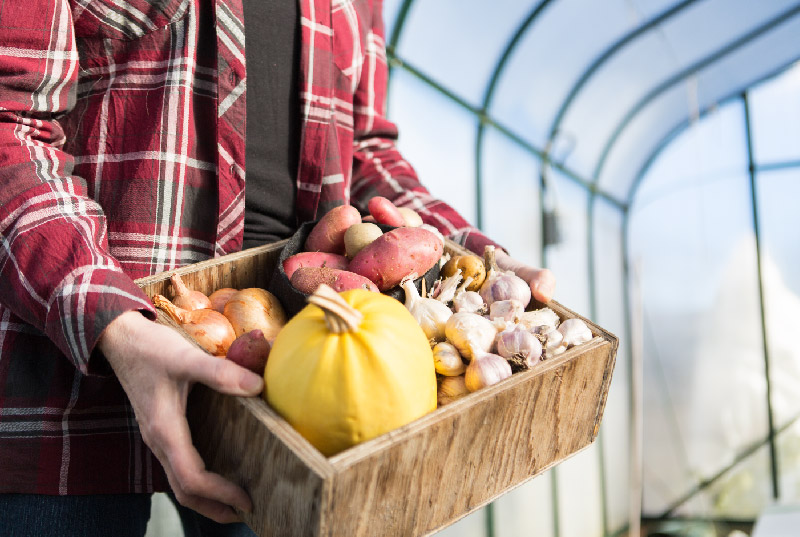
I help gardeners grow
& beginners blossom.
No seed left behind,
no soil unturned.
Together we can have lots of fun growing
great gardens using simple practical tips.
- Featured in -





Start saving & storing your garden seeds for a more more sustainable future
SIGN UP to get the FREE Seed packet PDF
X CLOSE

BIG VEGETABLES – HOW DO THEY DO IT?
I just returned from the #Canwest 2016 Horticulture show in Abbotsford, BC and I am excited to report there was a lot of cool stuff on display. I tested new knee pads and picked up a sample of Solex for the lemon and lime house my husband is designing for me.
While there I decided to write a new book, I toured City Farm and I interviewed Jaymie from Urban Peddlars. I ALSO saw Eddie’s big onion and Michael’s hefty garlic.
So what I really want to know is this: how do these gentlemen grow such big food?
Fertilizer of course. Eddies uses his own house brand (hear his interview below) “The Real McCoy” and Michael Dean uses his house brand “Gaia Green All Purpose”. It’s not exactly a Hatfiled and McCoy feud but one of the fellows did say he provided fertilizer to the other and did not get credit for it!
Maybe you grow seven hundred pound pumpkins? Or maybe you are the gardener reported on by the BBC this week who raised a record breaking 50 pound cabbage in England. So my question is this: why bother? I want to grow mineralized,organic, pest-free food. But does it really need to be giant?
I am still building my soil and I am not growing anything of record setting proportions except zucchini and no one seems to want those. So am I jealous? I am not sure I want the biggest cabbage or monster-scaled onions but I do want to grow mineralized and tasty food and if Elaine Inghamis right I can do it without supplements.
If you follow Ingham’s Soil Food Web directions and want to grow without artificial fertilizer you may not ever compete in the huge vegetable category like these fine gentlemen. But you will grow great food.

Michael of Gaia Green (www.gaiagreen.com) shows off his big (and heavy) garlic.
Today I will go out into my garden and chop and drop all the branches and twigs I am removing from my hugelkultur beds. (Yes I am hand-chopping with my machete until I can get the chopper/shredder I really deserve – more on that later.)
I will seed more fall rye and buckwheat to naturally enrich the soil and I will keep working with Debra Contreras of Nature’s Wisdom Organics (http://bit.ly/2d1S0tK) in Canada, testing my soil for biology, not chemistry. She is helping me discover and build the life in my garden so I can grow the best, not necessarily the biggest, food for myself and my family.
Hooray for food – however you do it!
Here is the transcript and audio from my interview with Eddi Les as he tells me about his secret to success:
Eddi: “I’ve grown bigger. My biggest one was seven [pounds]. I seed them around the first of January under lights and I put them out in March [in Langley]. I planted too many this year, too close, so I had to thin them out [in early August] and I gave all the smaller ones to staff.
DB: When did you have to thin them out?
Eddi: About six weeks ago [early August]. Because they were getting too close.
DB: So what’s your secret?
Eddi: I grow them in Real McCoy. It’s a real good fertilizer. It’s a mixture of steer manure and chicken manure. And it’s all organic and it’s got added organic fertilizer in it. It’s just a good product. Everything I grow is with Real McCoy. I use it on my lawn, when I had a lawn, I use it on all my flowers, my hanging baskets. My neighbourhood raves about my baskets.
I use it on everything.
NOTE TO GROWERS: EDDI DIDN’T SHARE THE VARIETY HE GROWS, but Al Chomika from Nanoose grows 5 lb onions from the variety Kelsae and the variety Ailsa Craig. Both can be found in the Westcoast Seed Catalogue. For spring 2017 I ordered Expression from William Dam seeds.
What Would Donna Do?
Get my growing and gardening tips and pointers throughout the season.
















0 Comments